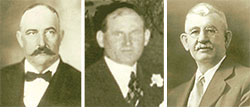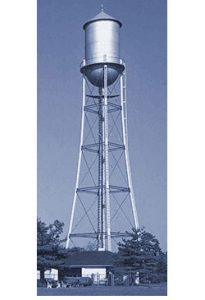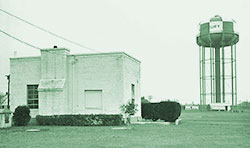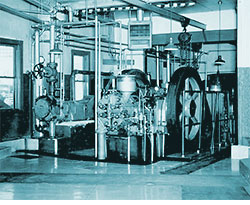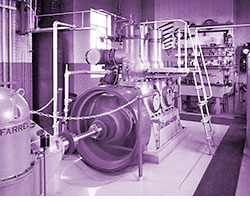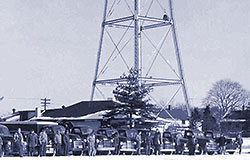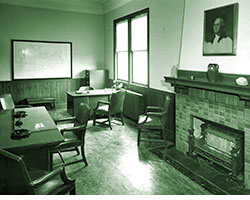History
In the Beginning
1904: In the early years, individual wells and cisterns were constructed to provide water to each residence and a sole well was situated in the downtown area for purposes of firefighting. So, in 1904, when a fire broke out in Westbury’s business district, the singular well was rapidly depleted and the fire department was left with no immediate source of water. Six years later, with this disastrous event still a vivid memory, a committee of concerned citizens worked diligently for a few short months to formulate a water district to supply water to less than 1,000 residents.
January 26, 1911: The adjacent newspaper clipping was discovered among historical archives tucked away at the Westbury Water District. In the January 26, 1911 edition of what is speculated to be The Westbury Times, which was founded in 1907, North Hempstead Town Clerk Monroe S. Wood posted this public notice. It was to announce a town board meeting on February 9, 1911 to consider a petition to establish a water district in the territory described in the news clipping.
February 17, 1911: Over one hundred years ago, the first meeting of the commissioners of the Westbury Water District was held. By April 3, the district had accepted bids for various services including laying pipes and setting fire hydrants as well as critical supplies such as valves, piping, a water tank and pumps. The district floated water bonds in the amount of $60,000 for this initial undertaking. By May of 1911, the first section of 8-inch pipe was laid on Maple Avenue, running from Grand Street to Ellison Avenue. By September of that year, well # 1 was situated at a depth of 505 feet, where water was pumped by vertical engines.
The water was kept in a 100,000 gallon storage tank, which was located near the water district’s main headquarters on Drexel Avenue.
Over the next 12 years, the district switched to gasoline run engines, then to kerosene engines that were used in conjunction with an ingenious air-lift pumping system that operated by forcing air into a well through a casement, thereby pushing water into a central in-ground reservoir. From this location, booster pumps fed the public distribution system. Each of these changes was made in an attempt to improve efficiency and reduce operating costs. By 1923, oil-powered engines were being utilized to handle the job. Progress was fast.
1924: The district began supplying water to neighboring areas such as Old Westbury and Carle Place, which eventually established their own water utilities in 1935 and 1949 respectively.
1947: The population of Westbury Village had increased to 4,525 by 1940, but it wasn’t until 1947 when the Westbury Water District installed a one-million-gallon above-ground storage tank. One decade later, when the population in the village had skyrocketed to 14,575, an additional 1.5-million-gallon underground tank was constructed on State Street.
1954: The New Cassel Water District became part of the Westbury Water District, which was also expanded to include a small service area north of Jericho Turnpike known as “Polo Field Park.” As the district’s boundaries became defined and the population being served by the water utility steadily increased so too did the number of wells needed to provide an adequate supply of water. By this time, they were being equipped with more modern electric pumps, which were eventually backed up by generators to ensure uninterrupted water service in the event of a blackout.
As the turn of the century became closer, water testing became more exacting and state-of-the-art equipment became more available to water purveyors, the district began introducing more modern equipment at its well sites and throughout the distribution system. Additionally, antiquated equipment and procedures were replaced over time by more current infrastructure and methods.
2003: With the installation of well #18 on Jericho Turnpike, the district was capable of pumping 18 million gallons of water per day. In 1995, the district’s first air-stripping tower was installed to remove any constituents that may be present in the water. Just prior to that, a new computerized system was added that is capable of operating the wells on an as-needed basis as the demand for water fluctuates according to season, temperature and time of day. These are only some samples of the numerous projects the district has undertaken in more recent times.
2018: Background on drinking water and emerging contaminants.
2020: Responding to COVID-19 and the pandemic. Received a deferral.
2021: First traces of emerging contaminants found in wells, two of which were taken offline. A 5-year capital improvement plan was developed and the District received a $65 bond approval from the Town of North Hempstead to design, construct and install state-of-the-art water treatment technology to remove emerging contaminants from the water supply.
2022 – 2023: The design and construction of the advanced oxidation treatment (AOP) plant at Drexel Avenue, Well No. 6 and No. 7A is now underway and will take two years to complete.
Present Day Overview
The water that gets delivered to a consumer’s home or business is tested regularly for more than 135 parameters and meets or exceeds all local, state and federal health department standards.
The District operates out of its headquarters at 160 Drexel Avenue in Westbury. Field workers, supervisors and the board of commissioners are equally committed to excellence when it comes to delivering an abundant supply of high quality water at an affordable rate.
As its founding members intended some 100 years ago, the Westbury Water District continues to be run by three commissioners who reside in the service area and are each elected by the public to serve a three-year term. They jointly oversee all functions of the district’s operating budget and are held responsible for working together in the best interest of public health and safety to ensure a continuous flow and abundant supply of water for domestic use and firefighting purposes. Together, they handle all fiduciary responsibilities, running the district much like a small business, rather than a large conglomerate.
The over-arching goal is to provide the residents of Westbury with a clean, safe, abundant water supply at a reasonable rate.

